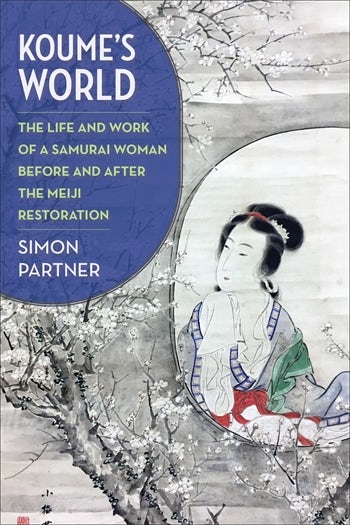Koume’s World
The Life and Work of a Samurai Woman Before and After the Meiji Restoration
Columbia University Press

Koume’s World
The Life and Work of a Samurai Woman Before and After the Meiji Restoration
Columbia University Press
Kawai Koume (1804–1889) was an accomplished poet and painter and a wife, mother, and grandmother in a lower-ranking samurai family in the provincial castle town of Wakayama. She was an eyewitness to many of the key events leading up to the Meiji Restoration and the radical changes that followed, including the famine of 1837, the great earthquake of 1854, the cholera epidemic of 1859, and the departure of samurai to fight in the civil wars of the 1860s. For more than fifty years, she kept a diary recording her family’s daily life—meals and expenses, visitors and the weather, small-town gossip and news of momentous events.
Through Koume’s eyes and words, Simon Partner opens a window on social, economic, and cultural life amid some of the most dramatic periods of Japan’s transformative nineteenth century. Koume’s World vividly portrays the everyday activities, social interactions, information networks, cultural production, and household economy of a samurai family across the Tokugawa-Meiji divide. Partner’s narrative offers a remarkably detailed portrait of the dynamic working life of a female artist and household manager while also giving a regional perspective on the upheavals surrounding the Meiji Restoration. A compelling microhistorical study of gender, economy, and society in nineteenth-century Japan, Koume’s World is a compelling account of how one woman experienced both mundane routines and drastic social transformations.
Through Koume’s eyes and words, Simon Partner opens a window on social, economic, and cultural life amid some of the most dramatic periods of Japan’s transformative nineteenth century. Koume’s World vividly portrays the everyday activities, social interactions, information networks, cultural production, and household economy of a samurai family across the Tokugawa-Meiji divide. Partner’s narrative offers a remarkably detailed portrait of the dynamic working life of a female artist and household manager while also giving a regional perspective on the upheavals surrounding the Meiji Restoration. A compelling microhistorical study of gender, economy, and society in nineteenth-century Japan, Koume’s World is a compelling account of how one woman experienced both mundane routines and drastic social transformations.
Simon Partner’s latest biography offers a fresh look at nineteenth-century Japan through the diary of a Wakayama artist. In elegant prose, Koume’s World reconstructs how this prolific painter gained the respect of her castle-town community and helped steer her family’s fortunes through tumultuous times. A valuable addition to the slim shelf of English-language volumes on Tokugawa women's lives. Kären Wigen, Stanford University
Simon Partner’s Koume’s World is a tremendously interesting account of the daily life of a samurai woman based on her detailed diary about how she took care of her household, engaged in painting and poetry, and observed her world. Partner employs many other sources to present an uncommonly sensitive view of regional urban society, in this case the understudied and fascinating city of Wakayama, which he reveals in its normal rhythms and the riveting drama pervading the collapse of the Tokugawa regime and the dynamic society of the early Meiji era. Luke Roberts, University of California, Santa Barbara
Simon Partner’s wonderfully engaging Koume’s World is chockablock with surprising details about the uncertain fortunes of a poor but respectable samurai family during a time of unprecedented change. Based on the matriarch’s diary, this book opens a window onto the travails of samurai in real life in mid-nineteenth-century Japan. David L. Howell, Harvard University
Koume’s World is a vivid portrait of a society changing under the impact of dramatic events and forces, but it is also a reminder of the events that make up all human life, no matter the time or place. Ian Rapley, Asian Review of Books
Highly readable and informative...a welcome addition to the small but growing corpus of resources for understanding the daily lives of women in the early modern period. Marcia Yonemoto University of Colorado, Boulder, American Historical Review
Preface and Acknowledgments
Kawai Family Tree
Monetary Values
Chronology
Introduction
1. Growing Up in Kishū Domain
2. A Year of Calamities
3. In the Shadow of the Black Ships
4. Work and Family
5. War and Revolution
6. The Artist’s Life
7. Across the Divide
Conclusion
Notes
Bibliography
Index
Kawai Family Tree
Monetary Values
Chronology
Introduction
1. Growing Up in Kishū Domain
2. A Year of Calamities
3. In the Shadow of the Black Ships
4. Work and Family
5. War and Revolution
6. The Artist’s Life
7. Across the Divide
Conclusion
Notes
Bibliography
Index
